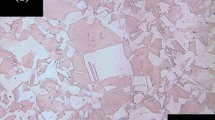Abstract
The effect of stacking fault energy (SFE) on the evolution of microstructures during room temperature tensile testing has been investigated at two strain rates of 8.3×10−4 and 1.7×10−1/s in pure copper, Cu-2.2%Al, and Cu-4.5%Al alloys with SFE values of, approximately, 78, 20 and 4 mJ/m2, respectively. The mechanism of deformation changes from simple slip leading to cell formation in the high SFE metal, Cu, to overlapping and/or intersecting deformation twins in low SFE alloy, Cu-4.5%Al. The effect of strain rate is such that it results in rather poorly defined cell boundaries in copper, with a smaller cell size at higher strain rates for similar grain sizes and strain values. The alloys deform by twinning and the propensity of deformation twins increases with both a decrease in SFE value and increase in strain rates.
Similar content being viewed by others
References
D. Sil and S. K. Varma, Metall. Trans. A, 24A (1993) 1153.
J. G. Rao and S. K. Varma, ibid. 24A (1993) 2559.
H. Shankaranarayan and S. K. Varma, Strain-rate and grain-size effect on substructures and mechanical properties in OFHC copper during tension, J. Mater. Sci. 30 (1995) 3576.
L. E. Murr, Interfacial Phenomena in Metals and Alloys (Reprinted by Techbooks, Herndon, VA, 1991) (originally printed by Addison-Wesley Publishing Co., 1975) pp. 145–148.
B. Bay, N. Hansen, D. A. Hughes and D. Kuhlmann-Wilsdorf, Acta Metall. Mater. 40 (1992) 205.
S. I. Hong and C. Laird, ibid. 8 (1990) 1581.
C. E. Feltner and C. Laird, Acta Metall. 15 (1967) 1633.
J. C. Huang and G. T. Gray III,, ibid. 12 (1989) 3335.
S. K. Varma, V. Caballero, J. Ponce, A. De la Cruz and D. Salas, submitted for publication in J. Mater. Sci.
_ S. G. Song and G. T. Gray III, Metall. Mater. Trans. A 26A (1995) 2665.
K. Wongwiwat and L. E. Murr, Mater. Sci. Eng. 35 (1978) 273.
R. E. Reed-Hill and Reza Abbaschian, "Physical Metallurgy Principles, Third Edition" (PWS-Kent Publishing Company, Boston, MA, 1992) p. 540.
L. E. Murr, M. A. Meyers, C-S Niou, Y. J. Chen, S. Pappu and C. Kennedy, "Shock-induced deformation twinning in tantalum," unpublished research (1995).
M. A. Meyers, U. R. Andrade and A. H. Chakshi, Metall. Mater. Trans (A) 26 (1995) 2881.
Rights and permissions
About this article
Cite this article
Caballero, V., Varma, S. Effect of stacking fault energy and strain rate on the microstructural evolution during room temperature tensile testing in Cu and Cu-Al dilute alloys. Journal of Materials Science 34, 461–468 (1999). https://doi.org/10.1023/A:1004526208389
Issue Date:
DOI: https://doi.org/10.1023/A:1004526208389




